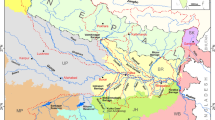Abstract
The Indus flood in 2010 was one of the greatest river disasters in recent history, which affected more than 14 million people in Pakistan. Although excessive rainfall between July and September 2010 has been cited as the major causative factor for this disaster, the human interventions in the river system over the years made this disaster a catastrophe. Geomorphic analysis suggests that the Indus River has had a very dynamic regime in the past. However, the river has now been constrained by embankments on both sides, and several barrages have been constructed along the river. As a result, the river has been aggrading rapidly during the last few decades due to its exceptionally high sediment load particularly in reaches upstream of the barrages. This in turn has caused significant increase in cross-valley gradient leading to breaches upstream of the barrages and inundation of large areas. Our flow accumulation analysis using SRTM data not only supports this interpretation but also points out that there are several reaches along the Indus River, which are still vulnerable to such breaches and flooding. Even though the Indus flood in 2010 was characterized by exceptionally high discharges, our experience in working on Himalayan rivers and similar recent events in rivers in Nepal and India suggest that such events can occur at relatively low discharges. It is therefore of utmost importance to identify such areas and plan mitigation measures as soon as possible. We emphasize the role of geomorphology in flood analysis and management and urge the river managers to take urgent steps to incorporate the geomorphic understanding of Himalayan rivers in river management plans.






Similar content being viewed by others
References
Ali KF, De Boer DH (2003) Construction of sediment budgets in large scale drainage basins: the case of the Indus river. In: Proceedings of sapporo symposium, July 2003, IAHS Publication 279:206–215
Ali KF, De Boer DH (2007) Spatial patterns and variation of suspended sediment yield in the upper Indus river basin, northern Pakistan. J Hydrol 334:368–387
Arifeen M (2010) Remodeling of sukkur barrage. The financial daily International. http://thefinancialdaily.com/news/views-opinions/remodeling-of-sukkur-barrage-14727.aspx. Accessed 24 Oct 2010
Bapalu GV and Sinha R (2005) GIS in flood hazard mapping: a case study of kosi river basin, India GIS@Development online edition, 1–3 (October, 2005 http://www.gisdevelopment.net/application/natural_hazards/floods/)
Bryant M, Falk P, Paola C (1995) An experimental study of avulsion frequency and rate of deposition. Geology 23:365–368
Dutt KL (2010) Pakistan floods: an anatomy of the Indus. http://www.abc.net.au/unleashed/29922.html#. Accessed 15 Nov 2010
Dutta D, Hearadth S (2004) Trend of floods in Asia and flood risk management with integrated rivers basins approach. In: Proceedings of the 2nd international conference of Asia-Pacific hydrology and water resources Association, Singapore, vol I. pp 55–63
EM-DAT (2010) List of top ten natural disasters in Pakistan. http://www.emdat.be. Excel sheet, Accessed 6 Nov 2010
Goswami DC (1985) Brahmaputra river, Assam, India: physiography, basin denudation and channel aggradation. Water Resour Res 21(7):959–978
Hovius N (1998) Controls on sediment supply by large rivers. In: Shanley KW, McCabe PJ (eds) Relative role of estuary, climate and tectonism in continental rocks, vol 59. Special Publication, SEPM, pp 4–15
Inam A, Clift PD, Giosan L, Tabrez AR, Tahir M, Rabbani MM, Danish M (2007) The geographic, geological and oceanographic setting of the Indus river. In: Gupta Avijit (ed) Large rivers: geomorphology and management. Wiley, New York, pp 333–345
Jain V, Tandon SK (2010) Conceptual assessment of (dis)connectivity and its application to the ganga river dispersal system. Geomorphology 118:349–358
Jain SK, Agarwal PK, Singh VP (2007) Hydrology and water resources of India. Water Sci Technol Libr 57:473–511. doi:10.1007/1-4020-5180-8-10
Khan B, Iqbal MJ, Yosufzal MAK (2009) Flood risk assessment of river Indus of Pakistan. Arab J Geosci 4:115–122. doi:10.1007/s12517-009-0110-9
Milliman JD, Quraishee GS, Beg MAA (1984) Sediment discharge from the Indus river to the ocean: past, present and future. In: Haq BU, Milliman JD (eds) Marine geology and oceanography of Arabian sea and coastal Pakistan. Van Nostrand Reinhold, New York, pp 5–70
Mimura N (2008) Asia-pacific coastal and there management: states of environment (Costal Systems and Continental Margins). Springer, ISBN-13: 978-1402036262
NASA Earth Observatory (2010) Flooding in Pakistan. http://earthobservatory.nasa.gov/NaturalHazards/event.php?id=44986. Accessed 17 Nov 2010
Pakistan Meteorological Department (2010a) Rainfall statement July-2010. http://www.pakmet.com.pk/FFD/index_files/rainfalljuly10.htm. Accessed 14 Oct 2010
Pakistan Meteorological Department (2010b) Rainfall statement August 2010. http://www.pakmet.com.pk/FFD/index_files/rainfallaug10.htm. Accessed 14 Oct 2010
Quan NF, Sheng TY, Ping XL, Wei FC (2010) DEM and ArcGIS-Based extraction of Eco-Hydrological characteristics in Ya’an, China. In: Proceeding of the Intelligent systems and applications (ISA), 2nd International workshop doi:10.1109/IWISA.2010.5473679
Sanyal J, Lu XX (2004) Application of Remote Sensing in Flood Management with Special Reference to Monsoon Asia: a review. Nat Hazards 33:283–301
Shrestha MS (2008) Impacts of floods in south Asia. J South Asia Disaster Stud 1(1):85–106
Sinha R (2008) Kosi: rising waters, dynamic channels and human disasters. Econ Polit Wkly 2008:42–46
Sinha R (2009) The great avulsion of kosi on 18 August 2008. Curr Sci 97:429–433
Sinha R (2010) A river runs through it. Public Serv Rev Int Dev 17:20–22
Sloff CJ (1997) Modelling reservoir sedimentation processes for sediment management studies, In: Proceedings of the conference hydropower into the next century, Portoroz, Slovenia, pp 513–524
Smith LC (1997) Satellite remote sensing of river inundation area, stage, and discharge: a review. Hydrol Process 11:1427–1439
Townsend PA, Walsh SJ (1998) Modeling floodplain inundation using an integrated GIS with radar and optical remote sensing. Geomorphology 21:295–312
Walling DE (2008) The changing sediment load of the mekong river. AMBIO J Hum Environ 37(3):150–157
Wang Y (2004) Using Landsat 7 TM data acquired days after a flood event to delineate the maximum flood extent on a coastal floodplain. Int J Remote Sens 25(5):959–974
Wang ZY, Plate EJ (2002) Recent flood disaster in China. Water Marit Eng 154:177–188
Author information
Authors and Affiliations
Corresponding author
Rights and permissions
About this article
Cite this article
Gaurav, K., Sinha, R. & Panda, P.K. The Indus flood of 2010 in Pakistan: a perspective analysis using remote sensing data. Nat Hazards 59, 1815–1826 (2011). https://doi.org/10.1007/s11069-011-9869-6
Received:
Accepted:
Published:
Issue Date:
DOI: https://doi.org/10.1007/s11069-011-9869-6




